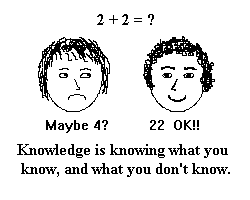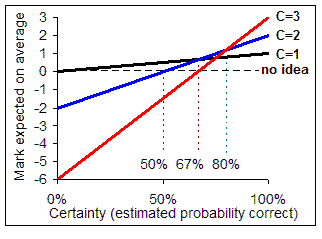Diferencia entre revisiones de «Usando Puntuación Basada en Certeza»
De MoodleDocs
m (tidy up) |
m (tidy up) |
||
| Línea 4: | Línea 4: | ||
'''Nota:''' Esta documentación está basada en el estudio muy detallado de [http://www.tmedwin.net/cbm/moodle/ Certainty-Based Marking] por Tony Gardner-Medwin. | '''Nota:''' Esta documentación está basada en el estudio muy detallado de [http://www.tmedwin.net/cbm/moodle/ Certainty-Based Marking] por Tony Gardner-Medwin. | ||
==Puntuación Basada en Certeza (''Certainty-Based marking, CBM'')== | ==Puntuación Basada en Certeza ('' Certainty-Based marking, CBM '')== | ||
* | *Después de cada respuesta, Usted dice qué tan seguro está de que su respuesta sea correcta. | ||
* | *Esto es en una escala de 3 puntos: C=1 (bajo), C=2 (medio) o C=3 (alto) | ||
* | *No nos confiamos en palabras como 'seguro' o 'muy seguro', porque estos conceptos significan cosas diferentes para personas diferentes | ||
* | *El esquema de puntuación y el riego de castigo determinan cuando Usted debería de usar cada nivel de C: | ||
==Cómo funciona CBM== | ==Cómo funciona CBM== | ||
[[File:cfmarks.gif|link=|]] | [[File:cfmarks.gif|link=|]] | ||
*Certainty levels 1, 2, 3 always give you marks 1, 2, or 3 when you are correct | *Certainty levels 1, 2, 3 always give you marks 1, 2, or 3 when you are correct | ||
Revisión del 19:10 11 nov 2013
Nota: Esta documentación está basada en el estudio muy detallado de Certainty-Based Marking por Tony Gardner-Medwin.
Puntuación Basada en Certeza ( Certainty-Based marking, CBM )
- Después de cada respuesta, Usted dice qué tan seguro está de que su respuesta sea correcta.
- Esto es en una escala de 3 puntos: C=1 (bajo), C=2 (medio) o C=3 (alto)
- No nos confiamos en palabras como 'seguro' o 'muy seguro', porque estos conceptos significan cosas diferentes para personas diferentes
- El esquema de puntuación y el riego de castigo determinan cuando Usted debería de usar cada nivel de C:
Cómo funciona CBM

- Certainty levels 1, 2, 3 always give you marks 1, 2, or 3 when you are correct
- If you are wrong, then unless you opted for C=1 you will lose marks: -2 at C=2 and -6 at C=3
Why use CBM?
- To make students think about how reliable their answer is
- To encourage students to try to understand the issues,not just react immediately to a question
- To challenge: if a student won't risk losing marks if wrong then they don't really know the answer
- If a student is a careful thinker but not very confident. they will gain in confidence
- It is more fair - a thoughtful and confident correct answer deserves more marks than a lucky hunch
- Students need to pay attention if they make confident wrong answers: think,reflect, learn!
- Efficient study requires constantly questioning how our ideas arise and how reliable they are.

Cómo decidir sobre el mejor nivel de certeza
- If you're sure, obviously you do best with C=3. But you will lose twice over (-6) if you are actually wrong!
- If unsure, you should avoid any risk of penalty by choosing C=1
- In between, you are best to use C=2: you gain 2 or lose 2 depending on whether you are right.
- The graph below shows how the average mark at each C level depends on the probability that your answer will be right.
- Suppose you think you only have a 50% chance of being right: The highest graph for 50% on the bottom scale is black, for C=1. So you will expect to boost your marks on average most by acknowledging your low certainty (C=1).
- If you think you can justify your answer well, with less than an 80% chance of being correct, then the red graph is highest, for C=3. Opt for this.

- Note that you can't ever expect to gain by misrepresenting your certainty. If you click C=3 (the red line) when you aren't sure, you will expect to do badly - with very likely a negative mark on average. If you understand the topic well, and think your answer is very probably right, then you will lose if you opt for C=1 or C=2 rather than C=3. You do best if you can distinguish which answers are reliable and which uncertain.
Puntuaciones
Para mayor información sobre puntuaciones (relacionadas con la versión UCL de CBM, aunque también es relevante para Moodle) por favor vea test scores with and without CBM por Tony Gardner-Medwin.